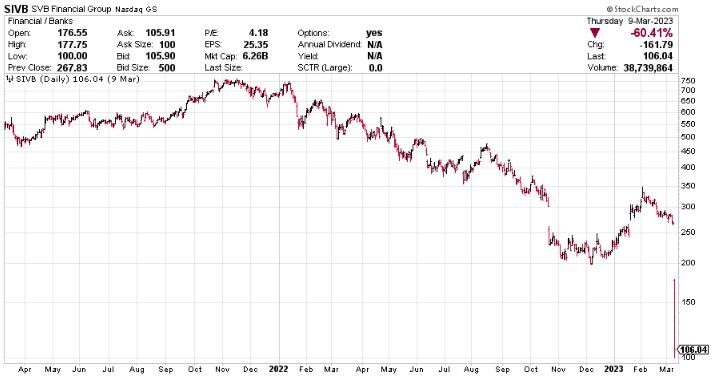
UPDATE #2: This is officially the second largest bank failure ever
UPDATE: California bank regulators have closed SIVB down – this typically means they will reopen on Monday in a different corporates format. We will see…
Yesterday, the 16th largest bank in the country lost > 60% of its market value. In the past 18 months, it has lost over 95% of its value. Yesterday, after losing >60% of its value it closed at $106. The graph above doesn’t show it due to a trading halt, but it has lost another 60+% today, trading at $39 as of 10am. October 2021 saw a high of $761, now we see $39. Wow is all I can say.
This is a big deal – it led to a run on the bank yesterday and forced them to liquidate assets at fire sale prices to fund the withdrawals requested by their clients. The $21 billion sale resulted in a $1.8 billion loss, requiring them to sell $1.75 billion in new common stock and convert $500 million in convertible preferred stock to plug the hole in their Tier 1 Capital. Current shareholders will be diluted 15% from this additional equity.
The question we all should be asking is whether this is another Lehman Brothers moment much like the start of the 2008 crash and Great Recession or is this an isolated event caused by the Fed’s increasing interest rates specific to the way SVB Financial does business. Lets think this through in the following paragraphs.
SVB Financial (SIVB), the Holding Company for Silicon Valley Bank, is in many ways a niche bank formed to service early stage technology and life science companies. From 2012 to 2021, as the Federal Reserve was flooding the market with liquidity, and investors were dumping billions of dollars into Silicon Valley start-ups, that money flowed into the bank and funded operating loans to these new businesses. In 2021, SIVB banked over half of all venture capital backed start-up and had nearly half of all technology and life science venture capital backed companies that went public that year.
With interest rates low, investors were happy to invest in the next big thing as long as the money was flowing free of charge from the Fed. Zero percent government rates meant valuations on these companies were absurdly high because the discount rate on projected (fictitious? over optimistic?) cash flow showed that these companies were worth billions even though they had never earned a penny. Unfortunately, the bank’s underwriting standards were likely skewed by these calculations of future cash flow – and it all worked great while rates were low. Now, after the fastest rate hiking cycle in history, those projections have proven wrong and their loan portfolio is majorly suspect.
When you look at the numbers using what we call “Cowboy Math” here at BankChampaign, they had 21% of their loan $75 billion loan portfolio out to early stage companies which equals over $15 billion. This is important because their equity capital equals $15 billion. If you have impaired loans equal to 100% of your capital, you are in for a visit from your primary regulator who will most likely be looking to close you down. The $2.25 billion in new equity that is being issued will ease up that impaired loan ratio to 85% of capital. Not good.
It is hard to know what will happen in coming days. If they have fixed their liquidity problem with the asset sale and new equity raised, and are not imminently going to close their doors, then maybe they can recover. If the liquidity issue continues, then most likely the government will force a sale to a competitor and current equity holders will end up with pennies on the dollar. It is very reminiscent of what happened to National City Bank in 2008 during the stock market crash. If you don’t remember it like I do, here is a link to an article that will give you a brief overview of its demise and forced sale to PNC Bank: National City acquisition by PNC – Wikipedia. There were a significant number of people in Champaign/Urbana that collectively millions of dollars when this happened. Their families had owned shares in the bank and its predecessors for generations, and that wealth was wiped out by the bank’s bad management decisions and lack of risk management.
So back to the original question: is this another Black Swan event like the Lehman Brothers liquidation that led the demise of other financial institutions like National City Bank or is this an isolated event due to the unique nature of SIVB’s business. If its the former, then we are in for an ugly time in coming months; if its the latter, then the current bear market should play itself out in due course.
My best assessment as of now is that this is isolated to SIVB (and other similarly situated banks with loan concentrations in risky industries) given its incestual relationship with venture capital funds and Silicon Valley start-ups. The other big banks do not have this same business model and their risk management practices are more stringent. This is also not the same banking system we had in 2008 as government requirements for higher Tier 1 Capital levels have made banks less leveraged and financially stronger. Bob Elliot from the Unlimited Funds group summarized it well on Twitter:
Quotes from Bob Elliot on Twitter today (March 10, 2023)“Banks are no longer the high leverage, risk taking institutions they were. They are well capitalized ‘boring businesses’ these days. So take these folks at SVB who booked their 1.8bln loss on their 3yr duration bond holding. Pretty small against a 200bln asset portfolio or 15% capital. Or that they have lost 10% of deposit base (16bln) over the last year against liquid securities of 120bln.
“Sure that’s not a great business. And it doesn’t help to have to raise another 2.25bln to cover the loss that was marked. But from a depositor perspective this process is working well! A loss was taken and then more equity is put into the bank to keep capital ratios up.
“Yes the common equity holders get hit with a lower valuation, but those folks are by designed the most leveraged to the bank profit outcomes. Right now the value of the common is back to 2016 levels and the bank still has a 6bln mkt cap on 200bln of assets.”
For the time being, for investment strategy purposes, I will proceed under the theory that only the niche banks operating in risky and aggressive businesses are subject to such extreme outcomes. SIVB, along with Silverlake ( the bank closely aligned with the Crypto business and FTX in particular), have felt the wrath of the current economic cycle. If we start seeing loan losses moving materially higher at less risky institutions, then the positive impact on bank earnings from higher rates will likely be offset by the need to expense additional funds to their loan loss reserve. In that case, we would want to reduce our exposure to the banking industry.
The market is acting as if this is a foregone conclusion and that we should expect material losses in the wider banking industry. The banks have sold off but if we don’t see mounting loan losses, then we will likely see a rebound in prices as earnings estimates are increased by expanding top line interest income revenues. Although there is no crystal ball that tells us what is going to happen, we will continue to watch for signs of weakening balance sheets and will reduce exposure if we see it. Until then, its watch and wait for the panic to subside and use the sell off as a buying opportunity if and when appropriate.
Mark


